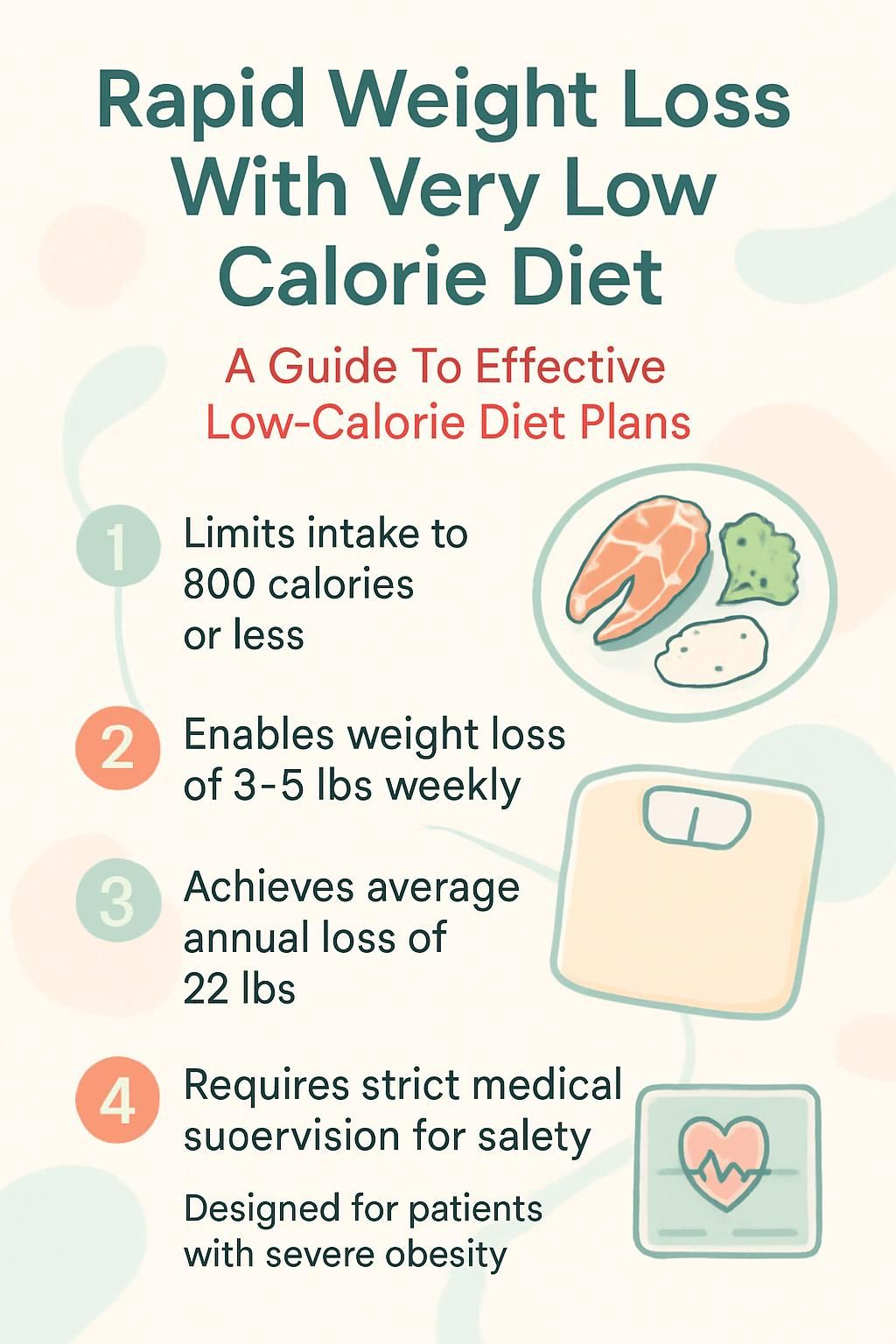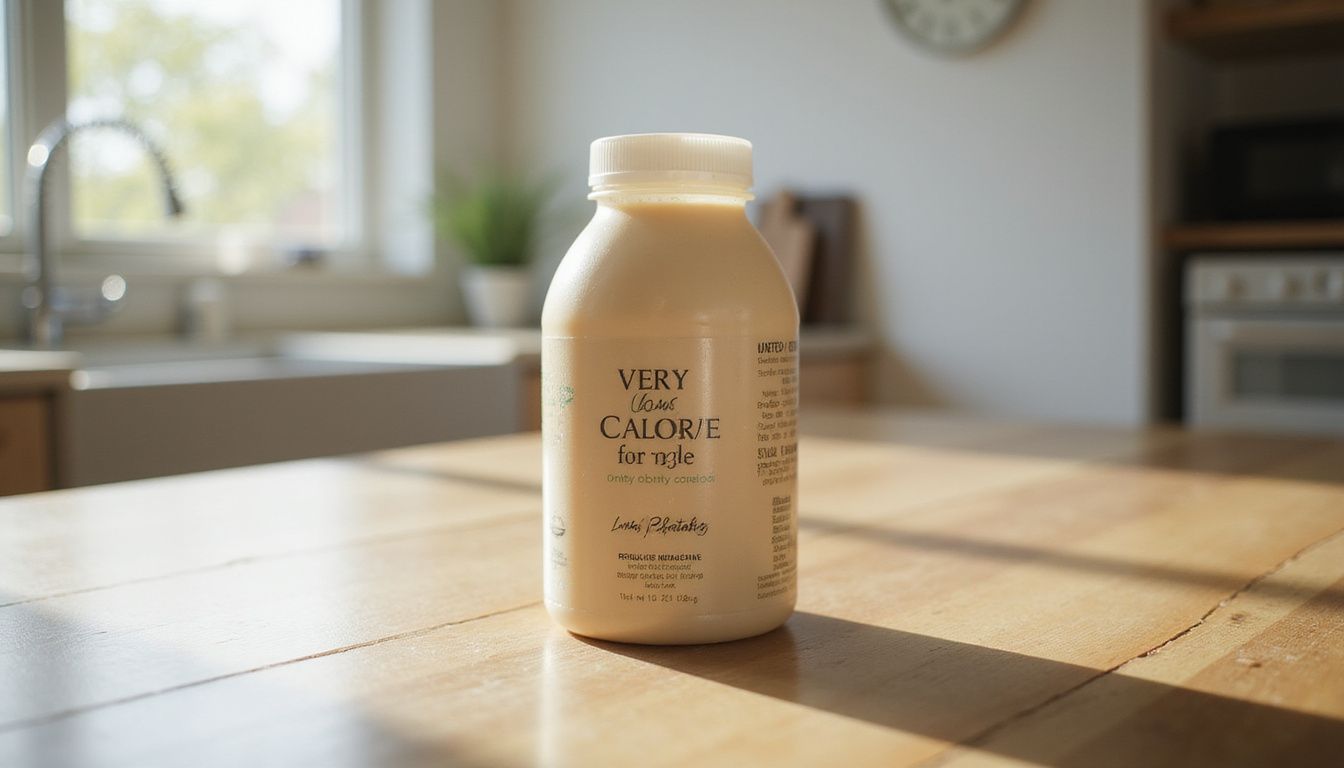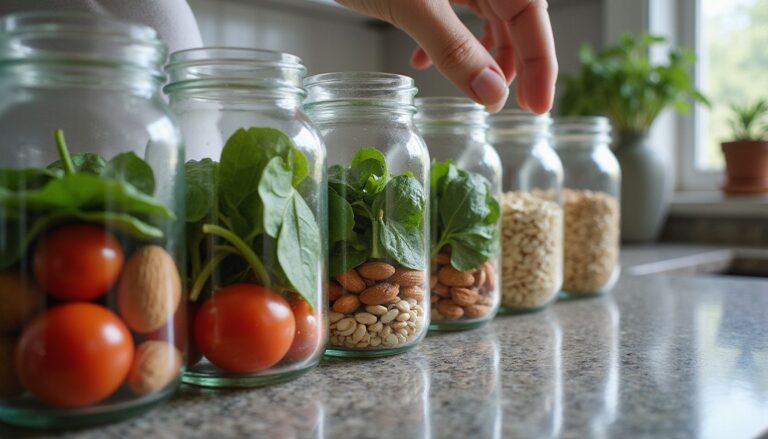Rapid Weight Loss With Very Low Calorie Diet: A Guide To Effective Low-Calorie Diet Plans
Our Nutrition Assistant AI Suite will transform your body. You will lose fat, get toned, and build muscle. Gain confidence and optimal health.
If you want fast results but feel stuck with stubborn fat, you are not alone. A very-low-calorie diet, often called a VLCD, can help adults with obesity lose weight quickly by limiting intake to about 800 calories a day and using meal replacements for full nutrition.
This guide shows how these low-calorie diet plans work, what they can do for rapid weight loss, and which risks to consider before you start. You will learn safe steps to protect muscle mass, energy, and health as you move toward your goals.
Keep reading for clear facts that can change how you manage your weight, from setup to long-term maintenance.
Key Takeaways
- A medically supervised VLCD caps intake at 800 calories or less per day. Many people lose 3 to 5 pounds per week and see better blood sugar, blood pressure, and cholesterol.
- Programs rely on nutritionally complete meal replacements, such as shakes and soups from brands like Optifast and Cambridge Weight Plan, to cover vitamins, minerals, protein, and essential fats.
- Research from systematic reviews and meta-analyses shows greater average weight loss than standard low-calorie diets, often about 10 kilograms, 22 pounds, over a year.
- Risks include gallstones, fatigue, muscle loss, electrolyte problems, and rare heart events. National guidance, including NICE and FDA warnings, supports strict medical supervision.
- Doctors use VLCDs mainly for severe obesity or before bariatric surgery. Children, teens, pregnant people, and older adults need close medical care if considered at all.

Understanding Very Low-Calorie Diets

A VLCD is a strict form of calorie restriction that supports rapid weight loss. These plans supply far fewer calories than typical diets, which changes energy balance and can speed fat loss.
What is a Very Low-Calorie Diet (VLCD)?
A VLCD limits your daily intake to 800 kilocalories or less. Doctors often use it for people with severe obesity or for short-term prep before bariatric surgery. Modern VLCDs use complete meal replacements that provide protein, vitamins, minerals, and essential fatty acids while keeping calories very low.
Some programs use total diet replacement, which means all meals come from approved products for a set time under medical care. Clinical trials and systematic reviews show strong weight loss when the calorie deficit is this large.
In practice, the toughest part is adjusting to low energy while staying hydrated and meeting nutrient needs. Seeing how VLCDs differ from other low-calorie diet options will help you choose a plan that fits your life.
How is a VLCD different from other Low-Calorie Diets?
A standard low-calorie diet, often called an LCD, usually allows 1,000 to 1,200 calories per day for women and up to 1,600 for men. A VLCD drops below 800. That bigger calorie gap brings faster weight loss but also more risks, which is why medical supervision is vital.
Meal replacements are the core of most VLCDs. You get pre-measured shakes or soups that deliver needed nutrients without extra calories. LCDs often mix meal replacements with whole foods. That mix is easier to sustain for many people in the long term.
On a supervised VLCD, one patient lost over fifteen pounds in four weeks. The structured plan reduced hunger over time and made snacking less likely.
VLCDs often help before surgery or as part of intensive programs for obesity or type 2 diabetes. Many randomized controlled trials and meta-analyses back these uses. If you choose this route, follow your clinician’s guidance closely.
How Do VLCDs Promote Rapid Weight Loss?
VLCDs create a steep calorie deficit. That leads to short-term weight loss for people who have overweight or obesity. Meal replacements or carefully planned foods limit calories while protein and light exercise help protect muscle.
What happens in the body during calorie restriction?
When you eat less, your body turns to stored energy. First it breaks down glycogen, the stored form of carbohydrate, which also releases water. This is why weight drops quickly in the first days. After glycogen falls, your body uses adipose tissue, or body fat, for energy.
Hormones shift too. Insulin levels fall, which supports fat burning. You may feel tired or weak at first, especially if you do not drink enough or meet protein needs. Without enough protein or strength work, as much as a quarter of early loss can come from lean body mass. That is why careful planning matters, especially if you live with type 2 diabetes.
How do meal replacements support VLCDs?
Meal replacements make VLCDs safer and simpler. Shakes, bars, and soups from programs like Cambridge Weight Plan, Exante, LighterLife, and Optifast often provide about 200 calories per item. They are built to meet standards for protein, vitamins, minerals, essential fats, and electrolytes set by health agencies.
These products lower the risk of vitamin or mineral gaps and often help control hunger. Adequate protein can limit muscle loss while you lose fat. Many people use such plans before bariatric surgery or as part of medical weight management with a dietitian’s support.
The right meal replacement can make following a VLCD much safer and easier, says Dr. Sarah Carter of the Department of Health and Human Services.
Some LCDs also include meal replacements for structure. Comparing plan types helps you choose the balance of speed, safety, and sustainability that you need.
Popular Low-Calorie Diet Plans Explained
Several plans cut calories in different ways. Each one affects fat loss, muscle, and long-term maintenance.
What is a Very Low-Calorie Diet (VLCD)? (Diet Plans)
A VLCD keeps daily intake at 800 calories or less. Doctors may use it for quick loss in people with obesity, to improve diabetes control, or to prepare for surgery. In the UK, the NHS Pathway to Remission uses total meal replacements for 12 weeks, then reintroduces food slowly over the next 12 weeks.
During a supervised VLCD, your care team may check blood pressure, electrolytes, and other labs. This helps prevent side effects like fatigue, gallstones, or muscle loss. Studies suggest an average of about 10 kilograms lost over a year with medical support and good protein intake plus exercise.
What is a Low-Calorie Diet (LCD)?
An LCD usually means 1,000 to 1,200 calories per day for women and 1,200 to 1,600 for men. Weight loss is slower than with a VLCD, but it is often easier to maintain. Many plans mix meal replacements with foods like lean meats, fish, eggs, tofu, vegetables, and some fruit.
This approach works for ongoing weight management and can support people with type 2 diabetes or high blood pressure. Many find it reduces hunger and fatigue compared with more severe cuts.
How does Time-Restricted Eating work?
Time-restricted eating limits the hours you eat each day. A common approach is 16:8, which means eating during an eight-hour window and fasting for sixteen. Calories are not always counted, but the schedule helps reduce snacking and late-night eating.
Studies suggest benefits for blood sugar control and metabolic health. Many people like it because it is simpler to follow than counting every calorie. It can pair well with nutrient-dense foods and steady routines.
What is Intermittent Fasting?
Intermittent fasting alternates regular eating with low-calorie or fasting days. The 5:2 method is popular. You limit calories on two nonconsecutive days each week, then eat a healthy diet the other five days.
Research shows this pattern may improve insulin sensitivity and body mass index compared with constant daily restriction. Many people prefer it because it offers breaks from strict limits while still supporting weight loss.
What Are the Benefits of Very Low-Calorie Diets?
VLCDs can lead to rapid weight loss and better metabolic health. Results can be striking in a short time with the right support.
How fast can you lose weight with a VLCD?
Under medical supervision, many people lose about 3 to 5 pounds, 1.5 to 2 kilograms, per week on a VLCD. Over a year, average loss is near 10 kilograms, about 22 pounds, which is about 4 percent more than many other low-energy diets in systematic reviews.
Your pace depends on adherence, metabolism, health issues, and physical activity. Early results can be motivating, but safety must come first.
How does a VLCD improve metabolic health?
Rapid weight loss often brings improvements in diabetes, cholesterol, and blood pressure. Studies show fasting glucose can drop within weeks on a VLCD. As body fat falls, insulin sensitivity improves and inflammation can decline.
Clinicians use VLCDs before surgery to reduce risks. Some patients see large gains in a few weeks, such as lower glucose readings and fewer medications. The structured nature of the plan helps produce these changes quickly.
How do VLCDs affect fat and insulin sensitivity?
With fewer calories coming in, your body burns stored fat. This reduces total fat and can shrink the fat that surrounds organs, which is helpful for blood sugar control. Many people with type 2 diabetes see better insulin action during the first 12 weeks of a supervised plan.
As insulin sensitivity rises, day-to-day energy and focus can improve. Some people need less medication, as guided by their doctor. Consistent habits and quality protein help protect muscle while fat drops.
What Are the Risks and Side Effects of VLCDs?
VLCDs carry real risks. Medical oversight reduces complications and helps you adjust the plan in time.
How to prevent nutritional deficiencies on a VLCD?
Choose a program that uses medically supervised total meal replacements. These products are regulated in places like Europe and Canada to meet daily needs for protein, vitamins, minerals, essential fats, and electrolytes. Balanced products lower the chance of malnutrition and refeeding syndrome.
Avoid fad diets or unregulated products. Work with a clinician who can order lab tests and adjust supplements. This helps protect your heart, bones, and muscles during rapid loss.
How to avoid muscle loss during a VLCD?
Protecting lean body mass is a top goal. Aim for at least 1.2 to 1.5 grams of protein per kilogram of body weight each day, unless your doctor advises otherwise. Include resistance exercise three times a week, such as dumbbell work or bodyweight moves like push-ups and squats.
Balanced plans that include enough protein and key minerals help you stay stronger as the scale moves. Skipping exercise or protein makes muscle loss more likely.
What are common side effects like fatigue and weakness?
Fatigue and weakness are common in the first weeks. Your intake is much lower than your body is used to, which can make daily tasks harder. Headaches, constipation, diarrhea, and nausea are also reported in some trials.
Low potassium or magnesium can worsen symptoms. Care teams often suggest hydration, electrolyte checks, and fiber strategies. If strict restriction goes on without oversight, risks rise for gallstones and electrolyte problems.
What are the risks of gallstones and electrolyte imbalances?
Fast weight loss can raise cholesterol in bile and reduce gallbladder contractions, which increases gallstone risk. Very low liquid plans under 400 calories a day were linked to deaths in the 1970s. Those events led to today’s FDA warnings and safer standards.
Electrolyte problems can occur if you do not replace minerals like potassium, sodium, magnesium, and calcium. Dehydration makes this worse. Early signs include cramps or irregular heartbeats. Hydration, lab checks, and proper supplementation help protect you.
Who Is a VLCD Suitable For?
A VLCD can help when you need to lose a large amount of weight quickly for health reasons. Medical supervision is essential from day one.
Should individuals with severe obesity try a VLCD?
People with a body mass index over 30 may qualify, especially if they have conditions like type 2 diabetes or obstructive sleep apnea. Research shows significant fat loss and better insulin sensitivity in many cases. Children, teens, pregnant people, and older adults should only consider this with specialist care.
Close monitoring reduces risks like gallstones and muscle loss. A structured plan, plus follow-up visits, leads to safer and steadier progress.
Is a VLCD recommended before bariatric surgery?
Many surgical teams ask patients to follow a VLCD for up to 12 weeks before bariatric surgery. Reducing liver fat and size makes the procedure safer and can lower complication risks.
Pre-surgery protocols from groups like the ERAS Society include low-calorie plans, sometimes low-carb, to improve the surgical field. Your team will tailor the details so your electrolytes and hydration stay on target.
Why is medical supervision important during a VLCD?
Medical supervision keeps you safe. VLCDs can cause dangerous electrolyte shifts, heart rhythm problems, or severe deficiencies if you go it alone. National guidelines recommend using VLCDs only as part of a structured program.
Clinicians check your vitals, labs, and symptoms, then adjust protein, fluids, or minerals as needed. This oversight limits harm and supports healthy weight loss.
What Foods Can You Eat on a VLCD?
Most VLCDs use meal replacements as the foundation. Some plans add small amounts of nutrient-dense foods under clinical guidance.
Which meal replacement options are allowed?
Most programs allow shakes, soups, bars, and similar products from brands such as Cambridge Weight Plan, Exante, LighterLife, and Optifast. Items usually supply around 200 calories and include protein, vitamins, minerals, and essential fats.
Many plans set a fixed number of portions per day. For example, some require several small meals to reach 800 calories. The NHS Pathway to Remission uses total diet replacements for 12 weeks with a daily cap of 800 calories.
| Meal Replacement Type | Calories Per Serving | Example Brand |
|---|---|---|
| Shake | ~200 kcal | Optifast |
| Soup | ~200 kcal | Cambridge Weight Plan |
| Snack Bar | ~200 kcal | Exante |
Meal replacements simplify planning and lower the chance of nutrient gaps. They make it easier to stick with the low-calorie target while protecting health.
What are good low-calorie, nutrient-dense foods?
Non-starchy vegetables add volume without many calories. Try broccoli, spinach, zucchini, mushrooms, peppers, cucumbers, and leafy greens for vitamins and minerals. Lean proteins like skinless chicken, white fish, shrimp, tofu, eggs, and cottage cheese support muscle while you lose fat.
Low-calorie fruits such as strawberries and watermelon can curb sweet cravings and help hydration. Fiber sources like chia seeds or cauliflower rice may ease hunger and reduce constipation. Research suggests fiber add-ons can improve comfort during VLCDs.
How much hydration is needed on a VLCD?
Aim for at least 8 to 10 glasses of water daily, about 2 to 2.5 liters. As your body uses glycogen, it releases water, which increases urine output. That raises your risk of dehydration.
Drink throughout the day and avoid sugary drinks. Many programs suggest checking urine color. Pale yellow usually means good hydration.
What Foods Should You Avoid on a VLCD?
Some foods can derail your plan with hidden calories and poor nutrition. Cutting them keeps your calorie budget for what your body actually needs.
Why avoid sugary drinks and processed foods?
Sugary drinks and ultra-processed foods add empty calories with little nutrition. Sodas, sweet teas, and fruit punches can spike blood sugar, then trigger cravings. That makes sticking to your calorie plan harder.
Processed snacks often contain added sugars, unhealthy fats, or excess sodium. They can promote inflammation and weight regain. Meal replacements or nutrient-dense snacks work better when your calories are tight.
Which high-fat and unhealthy snacks are off-limits?
Chips, pastries, and fried foods can use up most of your daily calories fast. A small bag of chips may top 150 calories with high fat but few nutrients. Fast foods like nuggets or onion rings often include added sugars and processed oils.
Limit fats to small portions from whole food sources, such as a few nuts or a slice of avocado, if your plan allows. This supports metabolic health and reduces gallstone risk while you lose weight.
How Can You Succeed on a VLCD?
Success comes from steady routines and close monitoring. Small, consistent actions protect your health while you lose weight.
Why follow healthcare professional guidance?
Healthcare professionals help you use a VLCD safely and effectively. They track labs and side effects and adjust protein, fluids, or supplements. This lowers the risks of gallstones, electrolyte problems, and muscle loss.
Your team can help you respond quickly if symptoms appear. That support makes it easier to stick with the plan and reach your goal.
How to monitor nutrient intake effectively?
Log every meal and shake using a food diary or app. Confirm that products are approved for your plan and meet daily targets for protein, vitamins, and minerals. Many VLCDs provide 70 to 100 grams of protein per day along with full micronutrient coverage at about 800 calories.
Schedule routine labs and checkups, often monthly during rapid loss. Set reminders for supplements like potassium or iron, if prescribed. Small gaps can lead to fatigue or muscle loss, so stay consistent.
How does exercise help maintain muscle on a VLCD? (Success)
Resistance training helps preserve muscle while calories are low. People who lift two or three times a week tend to keep more lean mass than those who do not exercise. This also supports your metabolism and day-to-day strength.
Simple plans work well. Use resistance bands or light weights. Pair training with enough protein to protect muscle while fat comes off.
What Role Does Exercise Play in VLCDs?
Exercise is a helpful partner to a VLCD. It supports muscle, mood, and long-term results.
How to maintain lean muscle mass during VLCD?
Do strength training two to three days per week. Focus on major muscle groups with movements like squats, rows, presses, and deadlifts. Many meal plans, such as Optifast, include at least 20 grams of protein per serving to help maintenance.
Aim for 1.0 to 1.2 grams of protein per kilogram of body weight daily unless your clinician sets a different target. This level supports muscle even during rapid loss. Structured exercise plus protein gives the best chance to hold onto lean tissue.
…
Reference: National Institutes of Health, Dietary Protein Intake and Human Health, July 2023.
How does exercise enhance fat loss results?
Exercise increases total daily energy burn. Aerobic work, such as brisk walking or cycling, uses stored fat for fuel. Strength training builds muscle, which raises resting metabolic rate so you burn more even at rest.
Recent studies show that pairing exercise with caloric restriction improves fat loss and lean mass retention compared with dieting alone. People who stay active also report better mood and energy during and after a VLCD.
What Are Alternative Low-Calorie Diet Options?
If a VLCD is not right for you, other plans can still reduce calories and support weight loss with fewer risks.
How do ketogenic diets compare to VLCDs?
A ketogenic diet cuts carbohydrates and raises fats, which can trigger ketosis. In ketosis, your body uses fat for energy instead of glucose. A VLCD focuses on total calories under 800 per day, often with structured meal replacements.
Both can reduce weight. Ketogenic plans sometimes feel more filling because of higher protein and fat. VLCDs often produce faster early losses due to water shifts, then fat loss. Either approach needs monitoring for nutrient balance and side effects.
What are Mediterranean low-calorie diets?
Mediterranean-style plans center on vegetables, fruits, legumes, fish, poultry, whole grains, and healthy fats like olive oil or nuts. Calories are reduced, but not as sharply as a VLCD. The focus is balance, variety, and fiber for satiety.
Many people lose weight steadily on this plan while also supporting heart and blood sugar health. It can be easier to follow long term, which helps with weight maintenance.
How to Maintain Weight Long-Term After a VLCD?
Maintenance starts as soon as you plan your transition. Keep your routines simple and repeatable.
How to transition gradually to a balanced diet?
Reintroduce whole foods slowly over about 12 weeks. Start with small portions of lean protein, vegetables, fruit, and whole grains, as your plan allows. This helps prevent rapid regain and gives your metabolism time to adapt.
Keep tracking calories and hydration. Work with your dietitian or clinician to adjust portions. Building skills during this stage prepares you for long-term success.
What habits help prevent weight regain?
Stay active for 150 minutes per week at a moderate pace. Keep portions modest and focus on whole foods. Many people who weigh themselves weekly and keep a food log are less likely to regain weight.
Ongoing support, such as group sessions or check-ins, improves long-term results. Set meal times, plan ahead, and drink water regularly. Small habits add up.
Frequently Asked Questions About VLCDs
Here are clear answers to common questions so you can use a VLCD safely and effectively.
Are Very Low-Calorie Diets safe?
Short-term, medically supervised VLCDs are generally safe for adults with obesity. Programs often last up to 12 weeks. Serious risks can occur without oversight, including muscle loss, dehydration, gallstones, and heart rhythm problems.
Some people should not use VLCDs, such as those who are pregnant or breastfeeding, children under 18, and people with certain heart or kidney conditions. Talk with your doctor to see if this approach fits your health needs.
How much weight can you expect to lose?
Many people lose 3 to 5 pounds per week with medical supervision. Average loss over a year is around 22 pounds. Results vary based on adherence, health status, and activity level.
| Time Frame | Average Weight Loss |
|---|---|
| Per Week | 3 to 5 lbs, 1.5 to 2 kg |
| One Year | ~22 lbs, ~10 kg total average |
Fast results can help you stay engaged. Always prioritize safety and work with a qualified clinician.
Can VLCDs be done without medical supervision?
No. National guidelines, including NICE recommendations, say VLCDs should only be used under medical supervision as part of a complete program. Unsupervised use has led to severe deficiencies, electrolyte problems, and rare sudden deaths in the past.
Medical teams monitor labs, heart health, and symptoms. That oversight keeps you safe while your body adapts to fewer calories.
Success Stories and Real-Life Examples
Real-world results show both the promise and the limits of VLCDs. Structure and support make the difference.
What do case studies reveal about VLCD success?
Case studies and health service programs report quick, meaningful loss under supervision. The NHS Pathway to Remission for type 2 diabetes has helped some participants reach remission through VLCDs and guided reintroduction of food.
Clinical reports often show 4 to 10 pounds lost per week during early phases, then slower loss as the program continues. Historic starvation experiments also warn against unsupervised restriction due to muscle loss and mood changes.
What lessons come from successful VLCD experiences?
People who do well follow medical guidance and use complete meal replacements. They plan the transition back to whole foods, then keep support in place. Regular check-ins lower relapse risk and help maintain new habits.
Structured follow-up, plus steady exercise and protein intake, supports weight maintenance. These lessons apply to other plans too, such as ketogenic or Mediterranean-style diets.
Conclusion
A very-low-calorie diet can deliver rapid weight loss when used with medical supervision and a clear plan. Meal replacements simplify nutrition at 800 calories per day, while protein and resistance exercise protect muscle.
Work with your healthcare team to reduce risks like nutrient gaps, gallstones, or electrolyte issues. Build long-term habits as you transition back to whole foods. With careful guidance and steady routines, you can reach your goal and keep the weight off.
Medical disclaimer: This article is for educational purposes only and is not a substitute for professional medical advice. Always consult your physician or a registered dietitian before starting any diet or exercise program, especially a VLCD.
FAQs
1. What is a very low calorie diet and how does it help with rapid weight loss?
A very low calorie diet, or VLCD, limits daily intake to about 800 calories or less. This approach can lead to quick weight loss by creating a large energy deficit. Clinical studies show that people following VLCDs often lose more weight in the short term than those on moderate diets.
2. Are there risks linked to using a very low calorie diet for fast weight loss?
VLCDs may cause side effects such as fatigue, dizziness, gallstones, and nutrient deficiencies if not supervised by medical professionals. Research from the National Institutes of Health highlights the need for regular monitoring during these plans.
3. Who should consider trying an effective low-calorie diet plan?
Doctors usually recommend VLCDs only for adults with obesity who have not succeeded with other methods and face health problems related to their weight. These plans are not suitable for children, teens, pregnant women, or people with certain medical conditions.
4. How do I follow a safe and evidence-based low-calorie diet plan?
Work closely with your healthcare provider before starting any strict eating plan like a VLCD. They will guide you in choosing meal replacements or foods that provide enough protein, vitamins, and minerals while keeping calories controlled; this helps protect muscle mass and overall health.
Summary: Very low calorie diets can result in rapid fat reduction but require careful planning under professional supervision due to possible health risks; they suit specific groups best when safer options fail.







